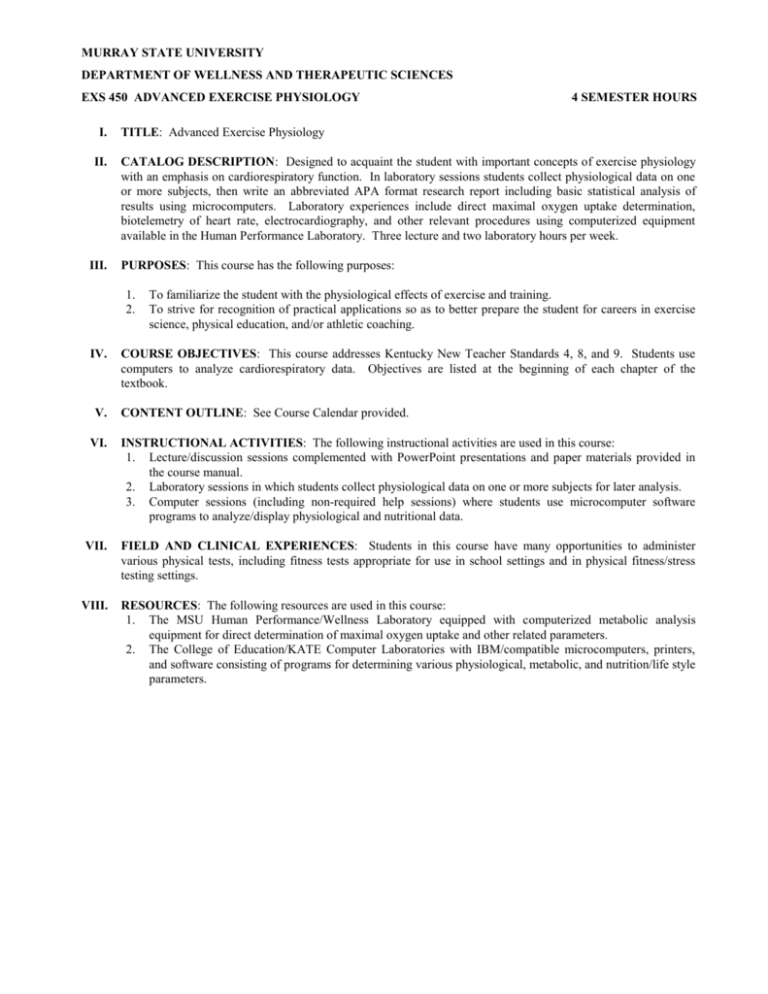EXS 450 - Murray State University
advertisement

MURRAY STATE UNIVERSITY DEPARTMENT OF WELLNESS AND THERAPEUTIC SCIENCES EXS 450 ADVANCED EXERCISE PHYSIOLOGY I. II. III. TITLE: Advanced Exercise Physiology CATALOG DESCRIPTION: Designed to acquaint the student with important concepts of exercise physiology with an emphasis on cardiorespiratory function. In laboratory sessions students collect physiological data on one or more subjects, then write an abbreviated APA format research report including basic statistical analysis of results using microcomputers. Laboratory experiences include direct maximal oxygen uptake determination, biotelemetry of heart rate, electrocardiography, and other relevant procedures using computerized equipment available in the Human Performance Laboratory. Three lecture and two laboratory hours per week. PURPOSES: This course has the following purposes: 1. 2. IV. V. 4 SEMESTER HOURS To familiarize the student with the physiological effects of exercise and training. To strive for recognition of practical applications so as to better prepare the student for careers in exercise science, physical education, and/or athletic coaching. COURSE OBJECTIVES: This course addresses Kentucky New Teacher Standards 4, 8, and 9. Students use computers to analyze cardiorespiratory data. Objectives are listed at the beginning of each chapter of the textbook. CONTENT OUTLINE: See Course Calendar provided. VI. INSTRUCTIONAL ACTIVITIES: The following instructional activities are used in this course: 1. Lecture/discussion sessions complemented with PowerPoint presentations and paper materials provided in the course manual. 2. Laboratory sessions in which students collect physiological data on one or more subjects for later analysis. 3. Computer sessions (including non-required help sessions) where students use microcomputer software programs to analyze/display physiological and nutritional data. VII. FIELD AND CLINICAL EXPERIENCES: Students in this course have many opportunities to administer various physical tests, including fitness tests appropriate for use in school settings and in physical fitness/stress testing settings. VIII. RESOURCES: The following resources are used in this course: 1. The MSU Human Performance/Wellness Laboratory equipped with computerized metabolic analysis equipment for direct determination of maximal oxygen uptake and other related parameters. 2. The College of Education/KATE Computer Laboratories with IBM/compatible microcomputers, printers, and software consisting of programs for determining various physiological, metabolic, and nutrition/life style parameters. IX. GRADING PROCEDURES: The grade in this course will be determined as follows: Percent of Grade Lecture Examinations Quizzes Laboratory Reports Notebook Attendance 50 15 25 10 5 (note that total is 105%!) Grading Scale 90-100% 80-89% 70-79% 60-69% 0-69% A B C D E LECTURE EXAMINATIONS: (50% of total grade) Three lecture exams of equal grade-weight will be given at approximately even intervals during the semester according to the course calendar. Exams will cover all information pertaining to lectures and laboratory sessions presented since the last such exam. Exams are designed to test knowledge of the information covered in lecture and laboratory periods, the textbook, and other assigned readings. Exams will consist of objective items (completion, true-false, multiple-choice), problem solving, and at least one essay question per examination. The third examination will be administered during the final examination period but will not be comprehensive and will have a weight equal to the other two examinations in the course. Except in the most extreme of circumstances, exams must be taken as scheduled. NOTEBOOK: (10% of total grade) Each student will keep a notebook which includes the following: All class notes in orderly, readable form; laboratory reports with procedures handouts; other handout materials; useful photocopy materials and articles, and anything else that will add to the present and future usefulness of such a notebook. The notebook will be graded and returned prior to or during the final exam period. Grade of 100 = a notebook that is properly bound with neat appearance, all pages of proper size and evenly hole-punched, plus all required inclusions (all materials provided through the course manual or in class, PowerPoint presentations, laboratory reports, study guides, class notes, etc. Notebook should have tabs for the several major categories of materials. A perfect grade implies a high quality notebook with signs of care and extra effort. Grade of 90 = a notebook which falls slightly short of above standard, but not by much. For this grade the notebook should have all essentials included, in orderly, neat fashion. Grade of 80 = everything present but not as neat and orderly as for above. Tabs not necessary. Binding must be adequate. Grade of 70 or less = less than above standards. The notebook must be bound using the binder included with the course manual available in the MSU Bookstore. The handouts and other materials that are used in the course should be preserved in good condition, free from doodling and other extraneous marks so that they will be suitable for inclusion in the notebook at the conclusion of the course. Additional information about submitting the notebook is given in the section below under “Laboratory Report Form.” QUIZZES: (15% of total grade) In order to encourage students to read the textbook chapters and laboratory procedures prior to their presentation in class, quizzes consisting of (usually five) multiple-choice/truefalse/completion or problem/calculation questions will be administered regularly, covering the assigned chapter or laboratory procedure for the day of the quiz. The quiz grade for the course will be calculated by determining the percent of correctly answered quiz questions during the entire course. Quizzes may not be made up, thus being absent or tardy on the day of a quiz will result in a grade of zero for that quiz. ATTENDANCE: (5% of total grade) This course adheres to the policy published in the MSU Undergraduate Bulletin. A possible 5 extra points may be earned through attendance. Since these points are above and beyond the usual grading items, the total for all graded items in the course adds to 105% rather than the usual 100%. Since attendance points are extra credit, there will be no allowances or excuses for missing class or lab other than those set fourth in the university policy. One accepted type of absence is university sponsored travel such as athletics, rodeo, drama team, etc. Notes from physicians, including the University Health Center will be accepted 2 as well. NOTE: It is possible to lose points beyond the five percent, should more than five classes or lab sessions be missed. Also please note that ordinarily the absolute maximum number of classes (including all regularly scheduled lecture and laboratory periods) that may be missed is eight (see “attendance policy” below under item X). Perfect Attendance = 1 absence = 2 absences = 3 absences = 4 absences = 5 extra points 4 extra points 3 extra points 2 extra points 1 extra point 5 absences = 6 absences = 7 absences = 8 absences = 9 absences = 0 points minus 1 point minus 2 points minus 3 points failure Note: Tardiness for lab or lecture counts as 1/3 of an absence LABORATORY REPORTS: (25% of grade) Eight laboratories requiring write-ups will be conducted, although only seven of these must be completed in order to receive a lab report grade based on 100 percent. If the eighth report is submitted the lowest grade of the eight labs will be dropped and, in addition, 20 points will be added to the grade of another lab report. Please note that you must attend the laboratory session in order to turn in a lab report for a grade. Each written lab report will be graded on the following 100-point scale: 100 90 80 70 60 10-50 0 = = = = = = = super job in all respects, signs of extra effort excellent paper, perhaps minor shortcomings good paper with all the essentials acceptable, but considerable problems incomplete or other serious problems severe problems no report submitted; too close a resemblance to another paper, past or present; report submitted after late report deadline Sufficient time will be allowed for students to submit their written lab reports, often 2-3 weeks, except near the end of the semester when time is limited. Due dates for labs are on the course calendar. Except in cases of extreme hardship when PRIOR consent is given by the instructor, laboratory reports turned in late will incur a 20% penalty (e.g., a grade of 90 becomes a grade of 70). NO LAB REPORT WILL BE ACCEPTED MORE THAN ONE WEEK LATE. Students may resubmit up to two lab reports for better grades, but only if they are resubmitted within one week of the student’s receiving the graded report. Every student must submit at least five of the eight lab reports, within the accepted time limit, with grades of at least 60 percent in order to successfully complete the course, no exceptions, since the laboratory component is a key aspect of the course. LABORATORY ATTENDANCE: With very limited exceptions, no laboratory report may be submitted if the student has not attended (or in some way made up for) the laboratory session. LABORATORY REPORT FORM: Lab reports should follow the general form used in Research Quarterly for Exercise and Sport and explained briefly in Laboratory Procedures and Course Materials. Lab reports must be computer generated, preferably using Microsoft Word word processing and Microsoft Excel spreadsheet software. The basics of using Word and Excel will be taught during an early laboratory session. This software is available for use in the College of Education K.A.T.E. Computer Laboratories, as well as in most other computing facilities on campus. Each student must independently produce his/her own word-processed laboratory reports. When turning in laboratory reports in paper format, clip (not staple!) the material together. When submitting lab reports remember that they eventually will go into your notebook, thus they must be of standard paper size with no folds or oversize pages. Margins must be appropriate for notebook binding and might as well already be three-hole-punched, since you will have to do this sooner or later. It is suggested that you remove all materials from the Laboratory Procedures and Course Materials manual and place them in a large three-ring notebook which you will bring to each class and lab meeting. The binder for the lab manual will be turned into the instructor at the beginning of the semester for safe keeping and for attaching a printed label. Near the conclusion of the course your binder will be returned to you at which time you may begin placing all original materials plus your graded lab reports and other materials into the binder. This “notebook” will then be turned in for grading during the final exam period at which time you will receive it back for future use and/or reference. 3 X. ATTENDANCE POLICY: This course adheres to the policy published in the MSU Undergraduate Bulletin. XI. ACADEMIC HONESTY: Cheating, plagiarism (submitting another person’s materials as one’s own), or doing work for another person, which will receive academic credit are, all impermissible. This includes the use of unauthorized books, notebooks, or other sources in order to secure or give help during an examination, the unauthorized copying of examinations, assignments, reports, or term papers, or the presentation of unacknowledged materials as if it were the student’s own work. Disciplinary action may be taken beyond the academic discipline administered by the faculty member who teaches the course in which the cheating took place XII. TEXT AND REFERENCES: Powers, Scott K. & Howley, Edward T. Exercise Physiology: Theory and Application to Fitness and Performance. Boston: WCB/McGraw-Hill, Undated Fourth Edition. (Required Text) Note: The Third Edition of the textbook may also be used in the course, as there are very few changes in the newer edition. Purcell, Ken. Laboratory Procedures and Course Materials, will be available MSU Bookstore. (Required Lab Manual) XIII. PREREQUISITES: Required prerequisites for this course include EXS 375—Biokinetics or EXS 475— Kinesiology, plus all general education math and science requirements, or the consent of the instructor. Recommended prerequisites include EXS 250--Fundamental Exercise Physiology and/or BIO 228 or 229, a general biology or physiology course such as BIO 101/199, and a high school/college chemistry course. 4









